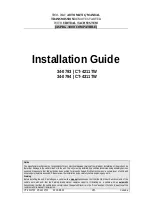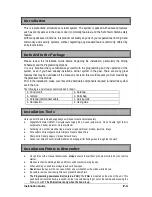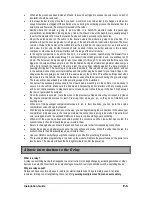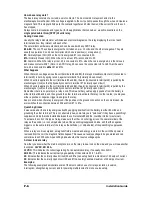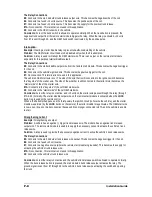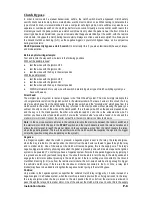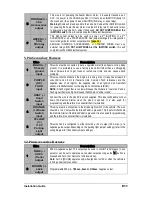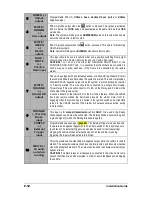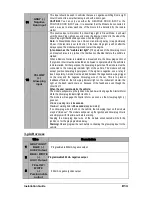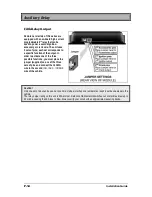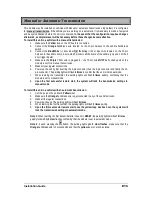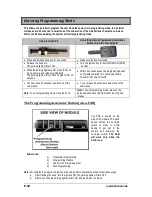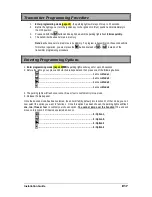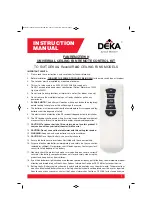
P-6
Installation Guide
How does a relay work?
The basic relay consists of a coil and a set of contacts. The most common relay mechanism is the
electromagnetic mechanism. When voltage is applied to the coil, current passes through the wire and creates a
magnetic field. This magnetic field pulls the contacts together and holds them until the current flow in the coil
has stopped.
Relays come in all varieties and types, but for the applications that concern us, we will concentrate on the
single pole double throw (SPDT) 12 volts relay.
Naming Convention
Usually the relay’s manufacturer will include an electrical diagram on the relay displaying the role of each
terminal and how they interact with each other.
These terminal numbers are standard, and can be used with any SPDT relay.
85 & 86: The coil. These inputs energize the coil when one is +12 volts, and the other is negative. They are
usually non-polarized, so it does not matter which one is positive (+) or negative (-).
87: Normally Open (N/O). When the coil is energized, 87 is connected to 30.
87A: Normally Closed (N/C). When the coil is at rest, 87A is connected to 30.
30: Common. When the relay is at rest, 30 is connected to 87A, when the coil is energized, it is then moved
and makes contact with 87. (Note: in a SPDT relay, 30 can never be connected to 87 and 87A at the same
time, 30 is connected to either 87 or 87A)
What happens
When there is no voltage across the coil (terminals 85 and 86), the relay's movable contact arm (connected to
terminal 30) is held, by spring tension, against terminal 87A (normally closed circuit).
When 12 volts is applied to the coil (terminals 85 and 86), the arm (connected to terminal 30) is pulled by the
electromagnet (coil) so that it physically connects to terminal 87 (normally open circuit).
When 12 volts is applied to the coil (terminals 85 and 86), the arm (connected to terminal 30) is pulled by the
electromagnet (coil) so that it physically connects to terminal 87 (normally open circuit).
Remember, there is no polarity on a relay’s coil. This means that you may apply positive from the battery to
either terminal 85 or 86, and then ground the other terminal to activate the relay. In other words, you may use
either a positive or negative trigger to energize the relay.
Keep in mind, when the relay is energized, if the positive or the ground connection on the coil is broken, the
arm switches the connection between 30 back from 87 to 87a.
Quenching Diodes
It was said earlier that a relay energizes itself by applying positive from the battery to either 85 or 86 and
grounding the other terminal. This is not absolutely true, some relays are “polarized” if they have a quenching/
suppression diode (A diode installed between the coil terminals 85 and 86, could be internal or external).
To activate the coil on this type of relay, make sure that the +12 volts trigger is on the same terminal of the
relay as the anode (+ or non striped side) side of the quenching/suppression diode, and that the negative
trigger is on the same terminal of the relay as the cathode (- or striped side) of the quenching/ suppression
diode.
When a relay’s coil is energized, a magnetic field is created and energy is stored in the coil. When power is
removed from the coil, the magnetic field collapses. This causes a reverse voltage to be generated and can
sometimes reach 200 volts. A quenching diode absorbs this reverse voltage spike.
A closer look at a relay
Now that you know what the main inscriptions are on the relay, take a look on the side, and you will see another
inscription: 12 VDC, 40/ 30 A.
12 VDC: This indicates the coil voltage rating. For an automotive relay, it's usually 12 volts DC.
40/ 30 A: This indicates the current carrying capability of the contacts 30, 87, & 87A.
40: Indicates that the normally closed circuit (30 and 87a) can safely handle a maximum of 40 amps of current.
30: Indicates that the normally open circuit (30 and 87) can safely handle a maximum of 30 amps of current.
Examples:
The following examples demonstrate some of the most common uses for relays: isolation, inversion,
interruption, strengthening current, and for powering multiple wires from one source safely.

